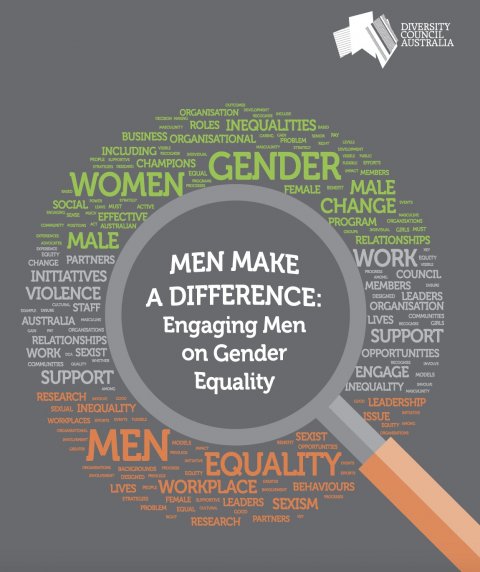
Initiatives aimed at ‘engaging men’ to address gender inequality have gained popularity in recent years. But how much do we really know about the most effective ways to engage men in gender equality?
In partnership with Dr Graeme Russell and Dr Michael Flood, two of Australia’s leading researchers in diversity and inclusion, DCA has released a new report, Men Make a Difference: Engaging Men on Gender Equality. The report examines the evidence for what works and what doesn’t, and recommends more effective ways to engage men to achieve gender equality at work.
Lisa Annese, DCA’s CEO, said men can play a crucial role in addressing gender inequality.
“Despite gains in recent years, gender inequality at work is still a major issue – you only have to look at the gender pay gap, the high incidence of pregnancy discrimination and the lack of women in positions of leaderships to see that.
“While engaging men is not a ‘magic bullet’, men are part of the problem of inequality so they need to be part of the solution. We have to find more effective ways to encourage men to work in partnership with women to create the necessary change. Importantly, men need to understand they will benefit from equality as well as women,” said Lisa.
Chris Sutherland, Managing Director of Programmed that sponsored report, said it is important research that contributes to the conversation about gender equality.
“At Programmed, we’re committed to the pursuit of gender equity in pay and jobs across leadership, operations and trades roles. A purposeful approach to diversity and inclusion enables us to gain broader perspectives and insights to better serve our customers.
“We seek to drive change not only within our organisation, but the wider community. To achieve gender equality, we need to engage men and women as active and equal partners,” said Chris.
Key report findings:
- Gender inequalities are everywhere
Gender inequalities are built into the systems and structures of our workplaces:
- Formally through policies and decision-making practices (e.g. denying promotion to part-time staff, as women are much more likely to work part-time than men), and
- Informally through norms and customs (e.g. ‘cultural fit’, ‘merit’, who gets included in or excluded in social and professional networks, language use, stereotypes, sexist and harassing behaviour).
Gender inequalities are also carried out by men and women at work:
- Many men, often without even realising it, practice other everyday forms of sexism.
- Men benefit from gender equality
- Men gain when the women and girls around them have lives which are safe and fair.
- Men’s wellbeing improves when the constraints of narrow notions of masculinity are relaxed.
- Men with feminist partners report greater relationship stability and sexual satisfaction than men with non-feminist partners.
- Men also benefit from active involvement as fathers in their children’s lives.
- With progress towards gender equality in workplaces, men will enjoy workplaces with greater productivity, creativity, and diversity because of the wider pools of talent and fairer processes on which they are based.
The most effective ways to engage men on gender equality at work:
- Get the foundation right – ensure gender equality initiatives involve women and men as active and equal partners.
- Get the framing right – treat gender equality as a business issue, not a women’s issue.
- Go wide – make visible and target all key gender equality areas (i.e. paid work, power and decision making, financial security, personal safety, interpersonal work relationships, caring, and community involvement).
- Get the messaging right – to appeal to men as well as women.
- Engage a diversity of men – including men in different organisational roles and levels, and with a variety of demographic backgrounds (e.g. ages, cultural backgrounds, sexual orientations).
- Educate about how to lead change effectively – by resourcing initiatives, being visible and persistent, and ‘walking the talk’.
- Make the connection between work and home – by implementing initiatives that encourage gender equality in caregiving.
- Make the connection between work and communities – by framing gender inequality as a societal/community problem.
- Build individuals’ gender confidence and capability – by providing opportunities for both men and women to change their mindsets, assumptions, and behaviours.
- Encourage men and women to challenge and change gender-biased organisational policies and practices.
Download the full report here. Also see Dr Michael Flood's speech at the launch, summarising the report, here.
Citation: Flood, M., and G. Russell. (2017). Men Make a Difference: How to Engage Men on Gender Equality. Sydney: Diversity Council Australia.
Note: Also see XY's collection of reports and guides on men's roles in building gender equality in workplaces and organisations.
About DCA
Diversity Council Australia is the independent, non-profit workplace diversity advisor to more than 400 organisations across the private and public sector – many of whom are among Australia’s largest and leading diversity employers. Our member organisations are estimated to employ more than one million Australians, representing around 10% of the Australian workforce.